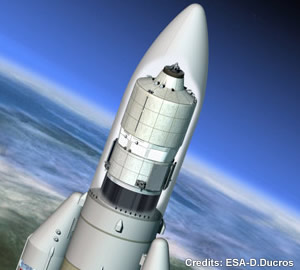|
| Launch
Configuration |
 |
Payload
envelope: 2 x 0.314 m3 and 2 x 0.414 m3 for each of 8 racks
Cargo
mass:
Dry
cargo: 1500-5500 kg
Water:
0-840 kg
Gas
(Nitrogen, Oxygen, air, 2 gasses/flight): 0-100 kg
ISS
re-boost and attitude control propellant: 0-4700 kg
Total
cargo upload capacity: 7667 kg
Launch
vehicle: Ariane 5 (260x260 km, 51.6° transfer path)
ATV
will be launched with its solar panels folded to the body of the spacecraft.
Electrical power will be supplied by non rechargeable batteries.
Launch
site Kourou, French Guianaon to a higher altitude to compensate for atmospheric
drag. |
|
 |
| Orbit Configuration |
 |
Deployed
solar arrays,with a total span of 22.3 m, that provide electrical power
to recharchable batteries for eclipse periods.
Automated
flight towards the International Space Station.
| Flight
Hardware |
 |
Propulsion
and re-boost system
Avionics
equipment
Guidance
Navigation and Control system
Communications
system
Power
generation and storage system
Thermal
Control System
Russian
docking and refuel system |
|
| Dimensions |
 |
Length: 9794 mm
Largest
diameter: 4480 mm
Solar
arrays span: 22281 mm
| Flight
hardware |
 |
Spacecraft
dry mass: 5320 kg
Cargo
carrier dry mass: 5150 kg
Total
mass dry mass: 10470 kg
Air/Consumables: 2613 kg
Cargo
upload capacity: 7667 kg
Mass
at launch: 20750 kg
Waste
download capacity: 6340 kg (5500 kg dry + 840 wet) |
| Propulsion |
 |
Main
propulsion system: 4 x 490 N thrusters
(Pressure
fed liquid bi-propellant system)
Attitude
control system: 28 x 220 N thrusters
(Pressure
fed liquid bi-propellant system)
Propellant:Monomethyl hydrazine fuel and Nitrogen tetroxide oxidizer
Pressurization: Helium pressurant at 31.4 MPa |
| Communications
infrastructure |
 |
To
ground: S-band via TDRS satellite
ATV
to ISS: S-band antenna
Navigation:
GPS |
| Thermal/Environmental
control |
 |
Thermal
Control: Multi Layer Isolation material, active thermal control using Variable
& Constant
Conductive
Heat Pipes and paints
Life
support control: Fire detection, air circulation, air temperature monitoring |
 |
| Electrical
power |
 |
Ascent
to ISS and de-orbit: 4 Solar panel wings of 4 panels each and 40 Ah
rechargeable batteries
Number
of arrays: 4
Number
of panels/array: 4
Generated
power: 3800 W after 6 months in orbit
Required
power supplied by ISS: < 400 W Dormant mode < 900 W Active
mode |
| Main
construction material |
 |
Pressure
shell: Al-2219
Micrometeoroid
and Debris Protection System:
Primary
bumper: Al-6061-T6
Secondary
bumper: Nextel/Kevlar blankets
Internal
structure (racks): Al-6061 T6
Thermal
insulation: Multi Layer Insulation blankets and aluminised betacloth
Solar
arrays: Silicium Solar Cells on 4 Carbon Fibre Reinforced Plastic Sandwich
panels |




